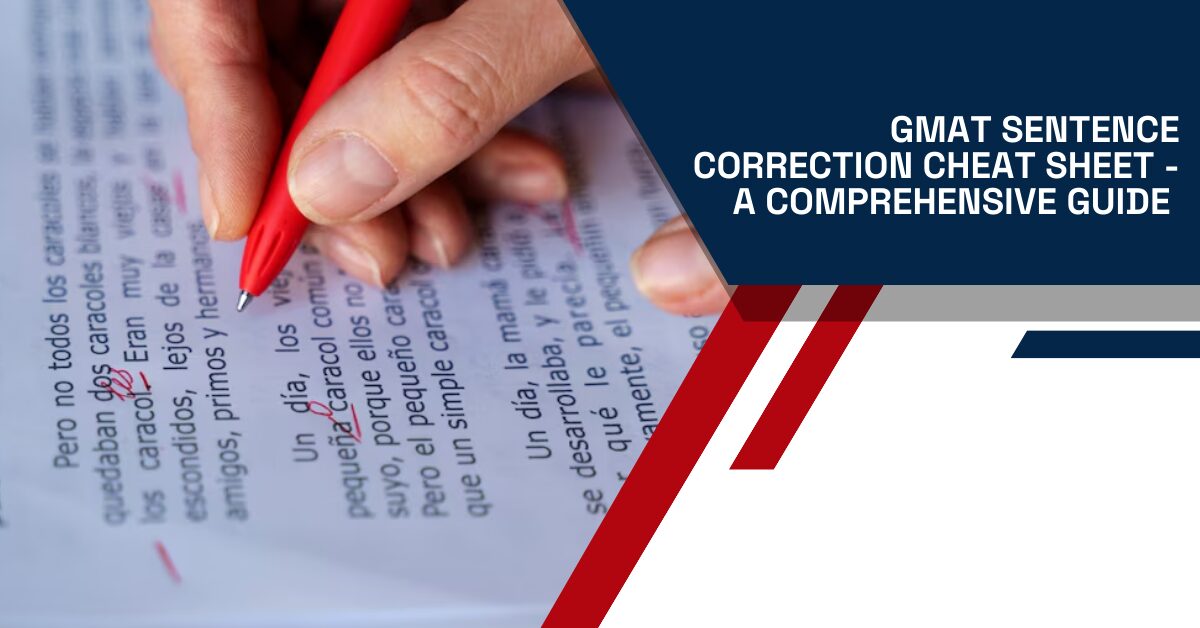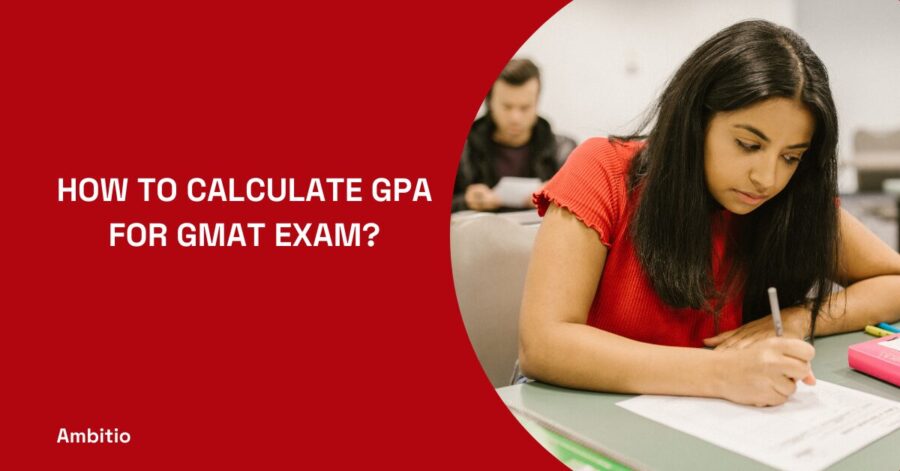16 December 2024
6 minutes read
GMAT Sentence Correction Cheat Sheet – A Comprehensive Guide

Key Takeaways
- Mastering grammar rules like subject-verb agreement, pronoun usage, and parallelism is crucial for GMAT sentence correction.
- Regular practice with quality GMAT prep materials and timed tests improves question format familiarity and accuracy.
- Avoid common errors by properly handling modifiers, interpreting non-essential clauses, and maintaining verb tense consistency to boost your GMAT verbal score.
Preparing for the GMAT requires mastering various skills, and sentence correction is a critical component of the Verbal section. This part of the exam tests your ability to recognize and correct grammatical errors, enhance sentence structure, and improve overall readability. In this comprehensive guide, we’ll provide you with a detailed cheat sheet to help you ace the GMAT sentence correction questions.
What Is GMAT Sentence Correction Questions?
Understanding GMAT sentence correction questions requires mastering various grammatical concepts. These questions test subject-verb agreement, verb tense, pronoun usage, and parallelism. The underlined portion of the sentence may contain errors involving singular nouns with singular verbs or plural nouns with plural verbs.
Modifiers, such as dangling modifiers, and non-essential clauses are often used to distract from errors. A pronoun must agree with its antecedent, and parallel structures must be parallel. Use a cheat sheet during GMAT preparation to simplify these concepts. Focus on recognizing idiomatic expressions, prepositional phrases, and correct construction for a better chance at selecting the correct answer.
Understanding the correct usage of gerunds, participles, adjectives, adverbs, and collective nouns can also enhance your GMAT verbal reasoning skills. Reviewing grammar rules and practicing with SC questions in PDF format will help you identify errors in the portion of the sentence and improve your performance. Out of the total number of GMAT verbal questions, 11-16 are from Sentence Correction. So, focusing on these areas can significantly boost your overall score.
GMAT Sentence Correction Cheat Sheet
Here’s a detailed cheat sheet to help you tackle these questions, including explanations, sample questions, and tips.
1. Subject-Verb Agreement
Ensure the subject and the verb agree in number and person. A singular subject requires a singular verb, and a plural subject requires a plural verb.
Sample Question: The committee, along with the chairperson, (has/have) decided to postpone the meeting.
Correct Answer: has
Tips:
- Identify the main subject and ignore intervening phrases.
- Eliminate answer choices that don’t match the subject in number.
2. Verb Tense
The tense of the verb must correctly indicate the time of the action. Consistency in tense is crucial, especially when describing actions in the past.
Sample Question: She (writes/wrote) the report after she (finishes/finished) her research.
Correct Answer: wrote, finished
Tips:
- Ensure verb tenses are consistent with the sequence of events.
- Look for clues indicating whether the action is in the past, present, or future.
3. Pronoun Agreement
A pronoun must agree in number and gender with the noun it replaces. Pronoun reference should be clear.
Sample Question: Each of the students must submit (his or her/their) homework on time.
Correct Answer: his or her
Tips:
- Identify the antecedent and ensure the pronoun matches in number and gender.
- Eliminate ambiguous pronouns that do not have clear antecedents.
4. Parallelism

Elements in a list or series, and constructions on either side of a conjunction, must be parallel.
Sample Question: She enjoys reading, (to write/writing), and (to swim/swimming).
Correct Answer: writing, swimming
Tips:
- Ensure all items in a series follow the same grammatical form.
- Keep comparisons equivalent.
5. Modifiers
Modifiers should be placed next to the words they are intended to modify to avoid ambiguity.
Sample Question: (Running quickly, the finish line) was in sight.
Correct Answer: Running quickly, she saw the finish line.
Tips:
- Make sure modifiers are placed next to the words they modify.
- Watch out for dangling or misplaced modifiers.
6. Idioms
Idiomatic expressions should be used correctly.
Sample Question: She is responsible (to take care of/for taking care of) the project.
Correct Answer: for taking care of
Tips:
- Familiarize yourself with common idiomatic expressions tested on the GMAT.
- Refer to an English grammar book or cheat sheet for idioms.
7. Comparison
Comparisons must be logical and complete, ensuring that the items compared are equivalent.
Sample Question: Her research is more thorough than (her colleagues/her colleagues’ research).
Correct Answer: her colleagues’ research
Tips:
- Keep comparisons equivalent.
- Ensure clarity by including possessive forms where necessary.
Common Mistakes to Avoid in GMAT Sentence Correction Questions
Follow GMAT beginner’s guide to have a better understanding of the exam and to effectively attempt it. Following are the common mistakes you should avoid when solving the GMAT Sentence Correction Questions.
- Ignoring the Non-Underlined Portion of the Sentence – The non-underlined portion provides context that can help clarify the intended meaning of the sentence.
- Assuming the Original Sentence is Correct – Always evaluate critically; many sentences are designed to have errors.
- Choosing Answers Based on Sound – Don’t choose an answer just because it “sounds right.” Ensure it follows key grammar rules.
- Overlooking Subject-Verb Agreement – Verify that the subject and the verb agree in number and person in every GMAT question.
- Ignoring Pronoun Agreement – Ensure that the pronoun agrees in number and gender with its antecedent.
- Missing Parallelism Errors – Make sure the word pair must be parallel and constructions on either side of conjunctions are grammatically parallel.
- Overlooking Modifiers – Make sure modifiers are placed next to the words they are intended to modify to avoid ambiguity.
- Neglecting Idioms – Use idiomatic expressions correctly, as these are frequently tested on the GMAT Adaptive Test.
- Ignoring Verb Tense Consistency – Ensure verb tenses are consistent with the sequence of events in the sentence, especially for actions in the past.
- Forgetting About Redundancy – Eliminate redundant words or phrases that do not add value to the sentence.
- Missing Comparative Structures – Keep comparisons equivalent and logical when dealing with comparison between two or more items.
- Neglecting Prepositional Phrases – Ensure prepositional phrases are used correctly within the sentence.
- Choosing the Longest Answer – Don’t assume the longest answer is the most correct. Focus on clarity and conciseness.
- Overlooking Conjunctions – Ensure the correct use of conjunctions, especially in complex sentences, and verify constructions on either side.
- Ignoring Agreement in Number and Person – Verify that nouns and pronouns match in number and person.
- Misinterpreting Non-Essential Clauses – Ensure non-essential clauses add clarity without altering the main meaning of the sentence.
- Missing Changes in Meaning – Ensure the answer choice maintains the original intended meaning of the sentence.
- Ignoring Verb Forms – Use the correct forms of verbs, especially irregular verbs and participles used to join clauses.
- Overlooking Commonly Confused Words – Pay attention to commonly confused words like affect/effect and further/farther.
- Skipping Practice – Regular practice with GMAT practice question papers, available online for free, is essential to improve your ability to spot and correct errors effectively.
How to improve your GMAT Sentence Correction Score?
By following the below strategies, you can systematically enhance your GMAT sentence correction skills and boost your overall score in the verbal section.
- Understand Grammar Rules:
- Master fundamental grammar rules, including subject-verb agreement, pronoun usage, verb tense, parallelism, and modifiers.
- Create a Cheat Sheet:
- Develop a GMAT sentence correction cheat sheet summarizing common errors and grammar concepts for quick review.
- Practice Regularly:
- Consistently practice with GMAT sentence correction questions to become familiar with the question format and common error types.
- Use High-Quality Resources:
- Study from reputable GMAT prep books and online resources that provide detailed explanations of grammar rules and question strategies.
- Focus on the Meaning:
- Always understand the intended meaning of the sentence before evaluating answer choices to ensure clarity and correctness.
- Eliminate Wrong Answers:
- Use the process of elimination to discard answer choices that contain obvious grammatical errors or change the intended meaning.
- Review Mistakes:
- Analyse your mistakes to identify patterns and focus on weak areas. Keep track of common errors and review them frequently.
- Understand Common Idioms:
- Familiarize yourself with idiomatic expressions commonly tested on the GMAT.
- Read Actively:
- Engage in active reading to improve your understanding of sentence structure and grammar in context.
- Take Timed Practice Tests:
- Simulate test conditions by taking timed practice tests to improve your speed and accuracy under exam pressure. Mastering GMAT time is really important.
- Get Feedback:
- Consider joining a study group or seeking feedback from a tutor to gain different perspectives on your performance and areas for improvement.
Conclusion
Mastering GMAT sentence correction requires a solid understanding of grammar rules, consistent practice, and strategic approaches to tackling questions. By using this cheat sheet, you’ll be well-equipped to identify common errors, apply the correct rules, and choose the best answers confidently.
With diligent preparation and a focus on improving your weaknesses, you can significantly boost your GMAT Verbal score and crack the GMAT with a good score. Happy studying!
Empower your GMAT journey with Ambitio’s expert strategies and resources. Our platform is designed to guide you to exceptional results, offering a blend of content mastery, practice opportunities, and analytical techniques that elevate your preparation and performance.
FAQs
What are common mistakes to avoid in GMAT sentence correction?
Common mistakes include ignoring subject-verb agreement, misusing pronouns, neglecting parallelism, placing modifiers incorrectly, and overlooking verb tense consistency. Avoid choosing answers based on what “sounds right.”
What are idiomatic expressions, and how are they tested on the GMAT?
Idiomatic expressions are phrases that have a figurative meaning different from their literal meaning. The GMAT tests your ability to use these expressions correctly within sentences.
How do modifiers impact GMAT sentence correction questions?
Modifiers should be placed next to the words they are intended to modify to avoid ambiguity. Misplaced or dangling modifiers can change the intended meaning of a sentence.
How can I identify subject-verb agreement errors?
Ensure the subject and verb agree in number and person. Singular subjects require singular verbs, and plural subjects require plural verbs. Check for intervening phrases that might obscure the main subject.
What are the most common grammar rules tested in GMAT sentence correction?
Common grammar rules include subject-verb agreement, verb tense consistency, pronoun agreement, parallelism, correct usage of modifiers, idiomatic expressions, and proper comparisons.
What is parallelism, and why is it important?
Parallelism ensures elements in a list or series, or constructions on either side of a conjunction, are grammatically similar. It improves sentence clarity and readability.

You can study at top universities worldwide!
Get expert tips and tricks to get into top universities with a free expert session.
Book Your Free 30-Minute Session Now! Book a call now




























